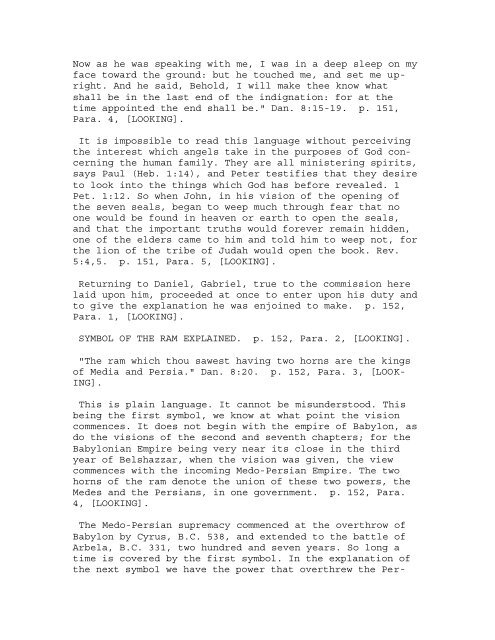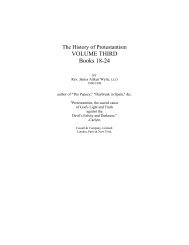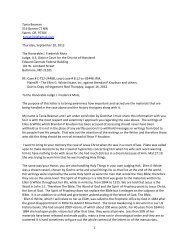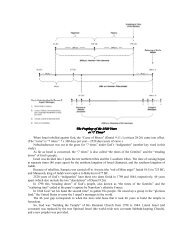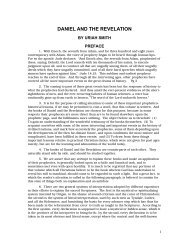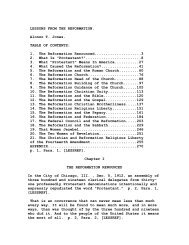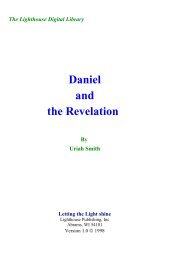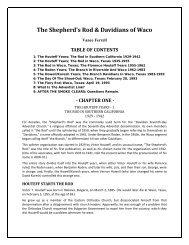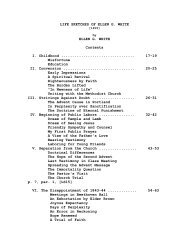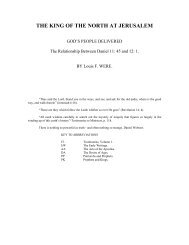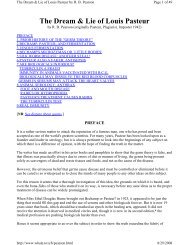LOOKING UNTO JESUS OR CHRIST IN TYPE AND ANTITYPE. BY ...
LOOKING UNTO JESUS OR CHRIST IN TYPE AND ANTITYPE. BY ...
LOOKING UNTO JESUS OR CHRIST IN TYPE AND ANTITYPE. BY ...
You also want an ePaper? Increase the reach of your titles
YUMPU automatically turns print PDFs into web optimized ePapers that Google loves.
Now as he was speaking with me, I was in a deep sleep on my<br />
face toward the ground: but he touched me, and set me upright.<br />
And he said, Behold, I will make thee know what<br />
shall be in the last end of the indignation: for at the<br />
time appointed the end shall be." Dan. 8:15-19. p. 151,<br />
Para. 4, [<strong>LOOK<strong>IN</strong>G</strong>].<br />
It is impossible to read this language without perceiving<br />
the interest which angels take in the purposes of God concerning<br />
the human family. They are all ministering spirits,<br />
says Paul (Heb. 1:14), and Peter testifies that they desire<br />
to look into the things which God has before revealed. 1<br />
Pet. 1:12. So when John, in his vision of the opening of<br />
the seven seals, began to weep much through fear that no<br />
one would be found in heaven or earth to open the seals,<br />
and that the important truths would forever remain hidden,<br />
one of the elders came to him and told him to weep not, for<br />
the lion of the tribe of Judah would open the book. Rev.<br />
5:4,5. p. 151, Para. 5, [<strong>LOOK<strong>IN</strong>G</strong>].<br />
Returning to Daniel, Gabriel, true to the commission here<br />
laid upon him, proceeded at once to enter upon his duty and<br />
to give the explanation he was enjoined to make. p. 152,<br />
Para. 1, [<strong>LOOK<strong>IN</strong>G</strong>].<br />
SYMBOL OF THE RAM EXPLA<strong>IN</strong>ED. p. 152, Para. 2, [<strong>LOOK<strong>IN</strong>G</strong>].<br />
"The ram which thou sawest having two horns are the kings<br />
of Media and Persia." Dan. 8:20. p. 152, Para. 3, [LOOK-<br />
<strong>IN</strong>G].<br />
This is plain language. It cannot be misunderstood. This<br />
being the first symbol, we know at what point the vision<br />
commences. It does not begin with the empire of Babylon, as<br />
do the visions of the second and seventh chapters; for the<br />
Babylonian Empire being very near its close in the third<br />
year of Belshazzar, when the vision was given, the view<br />
commences with the incoming Medo-Persian Empire. The two<br />
horns of the ram denote the union of these two powers, the<br />
Medes and the Persians, in one government. p. 152, Para.<br />
4, [<strong>LOOK<strong>IN</strong>G</strong>].<br />
The Medo-Persian supremacy commenced at the overthrow of<br />
Babylon by Cyrus, B.C. 538, and extended to the battle of<br />
Arbela, B.C. 331, two hundred and seven years. So long a<br />
time is covered by the first symbol. In the explanation of<br />
the next symbol we have the power that overthrew the Per-


